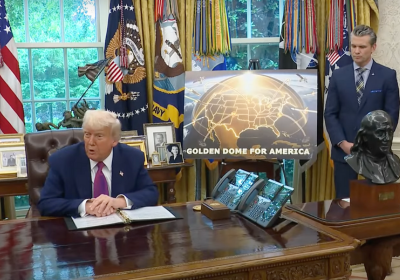Nuclear and defense strategists have long understood that the development and deployment of strategic missile interceptors is ineffective against determined nuclear-armed adversaries because it could lead them to build more numerous and sophisticated offensive missile systems — at relatively lower cost and more quickly -- to overwhelm and evade missile defenses.
Trump’s “Golden Dome” gambit flies in the face of these realities. Beyond the hoopla and hyperbole of “nearly 100 percent protection” within “three years," Trump’s “Golden Dome” strategic missile defense gambit is deeply flawed, technically complex, and counterproductive.

The layered missile defense system-of-systems that he promises would be even more costly than the $25 billion “down payment” that is in the yet-to-be approved Republican spending plan referenced in the Oval Office, and the $175 billion over three years that Trump claimed it would cost.
The Congressional Budget Office recently estimated that the cost of an ambitious space-based interceptor program that might be included in the defense plan Trump has sketched out could exceed well $500 billion over the next 20 years, and likely much more. And that program was originally scoped for the North Korean missile threat of 10 years ago – not today’s threat or the peers and near-peers Trump wants to defend against.
No matter how many hundreds of billions are spent on exotic crash programs, it is not realistic to believe that an effective system of missile defense systems will be feasible anytime soon, if ever, mainly because adversaries will respond by seeking to overwhelm missile defense systems in order to maintain their own capacity to deter U.S. conventional or nuclear attack.
As a result, Trump’s missile defense pitch is a con. It is a strategic blunder that will make Americans less secure and fatten the bank accounts of military contractors and Trump cronies and contributors like Elon Musk and his Space X investors.
For decades, serious U.S. national security and military leaders have recognized the need to prevent costly and destabilizing offense-defense strategic missile competition with the United States’ main nuclear rival, Russia, and now China. That is why Washington and Moscow agreed in 1972 to cap strategic missile interceptors to no more than 100 each under the terms of the Anti-Ballistic Missile (ABM) Treaty. Those limits facilitated progress on arms control and steep reductions in U.S. and Soviet/Russian offensive nuclear forces.
Even after the Bush administration decided to withdraw from the ABM Treaty in 2002 to try to expand strategic missile defenses against “rogue state” missile threats, U.S. policymakers have focused for the most part on improving capabilities to address limited attacks. To date, the Pentagon has only managed to field 44 strategic interceptors as part of the Ground-Based Midcourse Defense system. This system would be ineffective against Russia’s arsenal of some 450 land- and sea-based intercontinental ballistic missiles (ICBMs) and China’s smaller but growing arsenal of ICBMs.
As North Korea has improved its ballistic missile capabilities in recent years, however, Congress has poured billions of dollars more into the Missile Defense Agency to develop, procure, and test additional missile defense capabilities and explore new technologies.
But in 2019, the Trump administration’s Missile Defense Review recommended a more robust approach “to further thicken defensive capabilities for the U.S. homeland” to defend against the rogue-state threat. And, in a major departure from the traditional policy of defending against limited attacks from North Korea or possibly Iran, Trump also declared that the goal is to “ensure we can detect and destroy any missile launched against the United States anywhere, anytime, anyplace.”
In response, Moscow claimed it was developing new intercontinental-range nuclear delivery systems such as an undersea torpedo, hypersonic glide vehicle, and nuclear-powered cruise missile to ensure it can overcome any future U.S. missile defenses. China has already begun to respond to U.S. missile defense and conventional long-range strike capabilities by diversifying its nuclear deterrent force, including by increasing the number of silo-based ICBMs that are armed with multiple warheads.
President Trump 2025 “Golden Dome” concept is based on the same flawed logic he embraced in 2019, but with an even higher price tag.
If Congress rubber stamps Trump’s radical and unrealistic strategic missile defense gambit in full or in part, we should expect the Chinese nuclear arsenal to grow even more substantially and Russia to resist any offensive nuclear reductions—and to prepare seriously to break out — of the limits on strategic offensive nuclear deployments set by the soon-to-expire U.S.-Russian New Strategic Arms Reduction Treaty (START).
Absent a new U.S.-Russian agreement to maintain caps on their offensive strategic arsenals, the U.S. taxpayer might then be asked to spend even more than the $946 billion in projected costs to maintain and upgrade the existing U.S. nuclear force over the next ten years, in order to increase the size of the deployed nuclear force.
As a result, Trump’s strategic missile defense concept, if realized, would destabilize the already precarious nuclear balance of terror that exists between the United States and Russia and the United States and China and would leave the United States less safe and more insecure. -- DARYL G. KIMBALL
